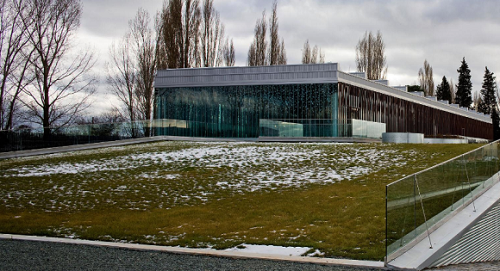
In February 2009 the Environmental Resources Center of Castilla-León was inaugurated in the city of Valladolid, Spain. Its comprehensive and exemplary PRAE (Environmental Education Proposals) concept is an environmental education project that comprises an Environmental Resources Center and the Environmental Park.
The two buildings are integrated as a complex for social, technical and educational use, with the aim of having fun, experimenting and developing environmental awareness. The concept seeks to convey the necessary knowledge and values to achieve a sustainable future.
In line with the objective of making the Environmental Resources Center an example of eco-efficient and bioclimatic architecture, Ferrovial Agroman applied sustainability criteria at each stage of the project – from the initial blueprints to its construction and operation. Reducing water and energy consumption were two key aspects in its development. Subsequently this effort was recognized by the Green Building Challenge, which accorded the center the highest rating of any of the buildings audited by this institution in Spain.
The Environmental Resources Center is shaped like a geometric prism and has a semi-basement level to lessen the impact on the natural environment. The total built surface area measures 3,500 square meters.
This building is oriented to take maximum advantage of sunlight, with the integration of appropriate sunscreens to optimize energy consumption throughout the year. It has also been designed around courtyards, affording natural light to all rooms in the building.
The design also features walls and a flat roof covered with plants that act as thermal insulation and help ensure the building blends in with the local landscape. The curtain wall is made of high thermal insulation glass and ensures optimal solar control. Additionally, there is a ventilated chamber that serves as a double skin. This significantly reduces both the heat gain and heat loss from the building throughout the year.
In regard to its construction, natural materials were chosen wherever possible that are both durable and recyclable. When building the walls, as well as using concrete and ceramic bricks with low thermal conductivity, cellulose fiber made from recycled paper was used for insulation making it possible to save considerably on energy use.
In terms of facilities, highlights of its design include the air conditioning and ventilation system: cold air is produced by a 200 kW absorption machine, complimented by a 120 kW, high-efficiency water chiller for the warmer seasons of the year. In both cases condensation of the refrigerant is achieved by using two cooling towers with independent circuits. Heat is produced by two 150 kW biomass boilers, using ground up pine cones as fuel, which are also a byproduct of the park. Heat production is complemented by the use of solar energy, with the installation of over 200 solar panels on the roof of the building.
Of special note are elements of the HVAC systems. One such example is the radiant heating and cooling floor, installed in public areas and hallways. Another is that the exhibition halls boast air handling units that incorporate a free air cooling section as well as cold and hot water supplied by circuits of variable water flow. The aim of this design is to reduce the energy consumption of different circulation systems. The offices were designed to employ thermal ventilation units which draw in air from the exterior and recover heat from it.
The parking facilities consist of pergolas made with in-built photovoltaic solar panels. These generate additional power for the complex.
Furthermore, the lighting systems utilize energy saving lamps, and a centralized management system controls the light intensity, according to specific needs, as well as efficiently managing the entire air conditioning system to ensure optimal comfort.
The center also boasts a rainwater collection system for reuse as irrigation water.
All of these measures make this building the perfect setting for visitors to learn a bit more about the energy and environmental challenges of the 21st century.





There are no comments yet